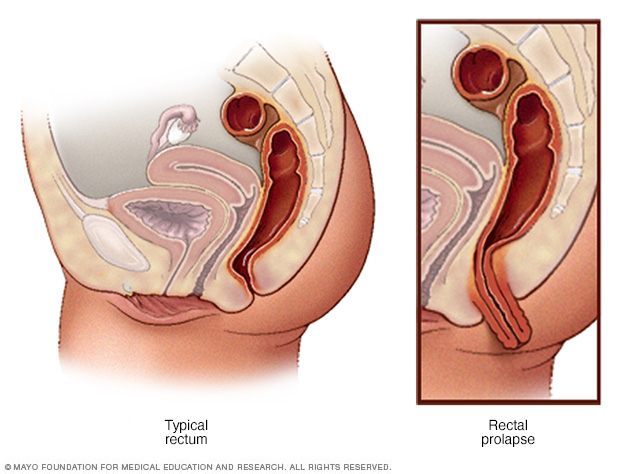Rectal prolapse occurs when part of the large intestine's lowest section (rectum) slips outside the muscular opening at the end of the digestive tract (anus). While rectal prolapse may cause discomfort, it's rarely a medical emergency.
Rectal prolapse can sometimes be treated with stool softeners, suppositories and other medications. But surgery is usually needed to treat rectal prolapse.

Rectal prolapse occurs when the rectum becomes stretched out and protrudes from the anus.
Symptoms
If you have rectal prolapse, you may notice a reddish mass that comes out of the anus, often while straining during a bowel movement. The mass may slip back inside the anus, or it may remain visible.
Other symptoms may include:
- The inability to control bowel movements (fecal incontinence)
- Constipation or diarrhea
- Leaking blood or mucus from the rectum
- Feeling that your rectum isn't empty after a bowel movement
Causes
The cause for rectal prolapse is unclear. Though it's a common assumption that rectal prolapse is associated with childbirth, about one-third of women with the condition have never had children.
Risk factors
Certain factors may increase your risk of developing rectal prolapse, including:
- Sex. A majority of people with rectal prolapse are women.
- Age. Rectal prolapse is more common in people over age 50.
Diagnosis
Sometimes it can be difficult to distinguish rectal prolapse from hemorrhoids. To help diagnose rectal prolapse and rule out other associated conditions, your doctor may recommend:
- Digital rectal exam. Your doctor inserts a gloved and lubricated finger into your rectum to evaluate the strength of your sphincter muscles and to check for any abnormalities in the rectal area. During the exam your doctor may ask you to bear down, to check for rectal prolapse.
- Anal manometry. A narrow, flexible tube is inserted into the anus and rectum. A small balloon at the tip of the tube may be expanded. This test helps measure the tightness of your anal sphincter and the sensitivity and functioning of your rectum.
- Colonoscopy. To rule out other conditions, such as polyps or colon cancer, you may have a colonoscopy, in which a flexible tube is inserted into your rectum to inspect the entire colon.
- Defecography. This procedure combines the use of a contrasting agent with an imaging study, such as x-ray or magnetic resonance imaging (MRI). Defecography can help reveal structural changes in and around your lower gastrointestinal tract and show how well your rectal muscles are working.
Treatment
Treatment for rectal prolapse usually involves surgery. Other treatments include various therapies for constipation, including stool softeners, suppositories and other medications. There are a few different surgical methods for treating rectal prolapse. Your doctor will choose the best approach for you after considering your age, physical condition and bowel function.
Copyright © 1998-2025 Mayo Foundation for Medical Education and Research (MFMER). All rights reserved.